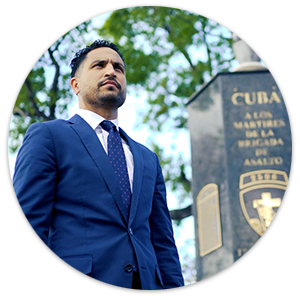When a pedestrian accident happens, the experience can be overwhelming for everyone involved. In Florida, with so many people walking, driving, and crossing streets, pedestrian accidents are unfortunately common. For those who have been hurt in a pedestrian accident, proving who is responsible is a major part of making a legal claim. Determining negligence, which means showing that someone else’s careless behavior led to the accident, is central to these cases. This process often involves answering important questions about the events leading to the accident, who was at fault, and what should happen next. At, The Guzman Firm, PLLC, we are here to guide you through the legal process and help you navigate the complexities of your case.
Richard Guzman’s expertise focuses on one primary objective: to offer tactical legal analysis, guidance, and result-driven solutions. The Guzman Firm is dedicated to providing you with the knowledgeable and competent counsel you deserve.
Attorney Richard Guzman
Understanding Negligence in Pedestrian Accidents
Negligence occurs when someone fails to act as carefully as they should in a situation, leading to harm to another person. In pedestrian accidents, proving negligence often means showing that the driver did not follow the rules of the road or did not pay proper attention, which caused the pedestrian to get hurt. Florida law requires drivers to be careful when pedestrians are nearby. This means drivers should watch for people on foot, follow traffic signs, and stop at crosswalks. In a negligence claim, the injured pedestrian must show that the driver did not take these actions or acted in a way that made the situation unsafe.
When looking at who may be at fault, the law also considers if the pedestrian did something that may have contributed to the accident. For example, if a pedestrian crosses the road outside of a crosswalk or ignores traffic lights, these actions might affect the claim. A pedestrian accident claim depends on understanding the actions of both the driver and the pedestrian leading up to the accident.
The Duty of Care Between Drivers and Pedestrians
In Florida, drivers and pedestrians owe a duty of care to each other. This means they must act in ways that avoid causing harm to one another. Drivers must drive carefully, obey speed limits, yield to pedestrians when appropriate, and watch for people walking along the roads. Pedestrians, on the other hand, must obey traffic signals, stay on sidewalks when available, and cross only at crosswalks. When either a driver or pedestrian breaks these rules and someone gets hurt as a result, the one who broke the rules may be considered negligent.
Proving that the driver or the pedestrian did not uphold this duty of care can be challenging. Both parties’ actions must be reviewed carefully to determine whether the driver failed to yield, was speeding, or was distracted, or whether the pedestrian crossed at a dangerous place or did not follow traffic signals. For a successful claim, showing the facts that prove either the driver or pedestrian acted irresponsibly is necessary.
“Richard is deeply invested in his community and is a professional of purpose and integrity. As our legal counsel, his strategic approach, proactive communication, and commitment to our organization’s needs and goals have helped us navigate challenges as well as build important partnerships.” “I go to Richard Guzman because of trust. He was recommended by my dear sister that had the pleasure of working with Mr. Guzman. By having a direct recommendation, I did not doubt that he could ease my worries and that I would be backed by a knowledgeable, trustworthy professional.”![]()
Dejha C.
![]()
Piero S.
Did the Driver Break Traffic Rules or Drive Distractedly?
One key question in proving negligence is whether the driver broke traffic laws. In Florida, drivers are expected to follow all traffic signs and signals, and failing to do so may lead to accidents. Running a red light, not stopping at a stop sign, or ignoring a pedestrian crosswalk are examples of actions that may be considered negligent. When a driver disregards traffic rules, they may be held responsible if this behavior directly led to the pedestrian’s injury.
In many cases, accidents happen because a driver is distracted. This could mean the driver was texting, eating, talking on the phone, or otherwise not fully focused on the road. Proving that a driver was distracted often involves gathering evidence, such as phone records, witness statements, or traffic camera footage. If it can be shown that the driver was not paying attention and this caused the pedestrian accident, the driver may be found negligent and responsible for the harm caused.
Did Weather or Road Conditions Contribute to the Accident?
Sometimes, road conditions or the weather play a role in pedestrian accidents. Wet roads, foggy weather, and other conditions can make it harder for drivers to see pedestrians or stop quickly. Florida has frequent rain, which can make roads slick and reduce visibility. While drivers are not at fault for the weather, they are still expected to adjust their driving to match the conditions. A driver who fails to slow down in heavy rain or does not turn on their headlights in low visibility may still be considered negligent because they did not drive carefully given the road conditions.
Pedestrians must also be cautious in these conditions. When visibility is low, pedestrians should take care to cross safely and remain alert. If a driver acted responsibly given the conditions, yet an accident occurred because a pedestrian was not careful, the pedestrian’s role in the accident may be considered. However, if a driver ignored the risks that weather presented, this could be an important point in proving negligence.
Was the Pedestrian in a Safe Place?
Where a pedestrian is located at the time of an accident also matters when determining negligence. Pedestrians are expected to use crosswalks and obey traffic signals. In many cases, Florida law favors the pedestrian’s right to be safe, especially when they are in designated pedestrian areas like crosswalks. If a pedestrian was hit while crossing the street in a crosswalk or at an intersection with a signal, it may help show that the driver failed to yield as required by law.
However, if a pedestrian crosses a busy road in an area without a crosswalk or steps out suddenly into the path of a vehicle, this could affect the negligence claim. In these situations, it may be argued that the pedestrian took an unnecessary risk. Nonetheless, Florida law generally favors the pedestrian’s right to travel safely, especially when they are obeying the rules. This makes crosswalk and signal usage important factors in proving a negligence case.
Gathering Evidence for a Pedestrian Accident Claim
To prove negligence, gathering strong evidence is necessary. The process of gathering evidence includes collecting photos, witness statements, police reports, and sometimes video footage. Pictures of the accident scene, damage to the vehicle, and any visible injuries are helpful in showing what happened. Witnesses who saw the accident or can explain what each party was doing may also provide valuable information.
Police reports are another key source of evidence. When police arrive at the scene, they usually prepare a report that includes details on what may have led to the accident. This report may note if the driver appeared distracted or if any traffic laws were broken. In some cases, video footage from nearby cameras may show the accident as it happened. If the video shows the driver speeding or ignoring a traffic sign, this footage may be crucial in proving negligence.
Proving Injuries and Damages in a Pedestrian Accident
Besides proving that the driver was negligent, it is also necessary to show that the accident led to injuries and damages. This part of the claim involves providing medical records, proof of medical bills, and showing any other costs linked to the accident. Injuries in pedestrian accidents can be severe, ranging from broken bones to head injuries, and proving these injuries is key to a successful claim.
If an accident causes someone to miss work, it may also be possible to claim lost wages as part of the damages. These financial losses must be carefully documented. Medical records help show the extent of injuries, while bills and receipts show the costs of treatment. In cases where injuries affect a person’s ability to work or live as they did before, these changes may be included in the damages sought.
What Role Does Comparative Negligence Play in Florida?
Florida follows a system known as comparative negligence, which means that both the driver and pedestrian’s actions are considered when determining who is at fault. If the pedestrian is found partially responsible for the accident, it does not automatically prevent them from seeking compensation. Instead, the pedestrian’s portion of fault may reduce the total amount of compensation they receive.
For example, if a court finds that a pedestrian was 20 percent at fault because they crossed outside of a crosswalk, their compensation might be reduced by that amount. Comparative negligence allows the injured pedestrian to still recover some compensation, even if they were partially responsible. Understanding this rule is important for anyone seeking to prove negligence in a pedestrian accident claim in Florida, as it impacts the potential outcome of the case.
The Importance of Legal Help in a Pedestrian Accident Claim
Proving negligence in a Florida pedestrian accident can be a complex process. From gathering evidence to dealing with comparative negligence rules, each part of the claim requires careful attention. An experienced legal team can provide guidance, help gather necessary evidence, and represent the interests of the injured pedestrian. Working with a law firm ensures that the process is handled properly and increases the likelihood of a fair outcome.
If you or a loved one has been hurt in a pedestrian accident and you believe negligence was involved, The Guzman Firm, PLLC is here to help. Our dedicated team understands the complexities of pedestrian accident cases in Florida and will work to help you seek the compensation you deserve. Contact us today to discuss your case and learn how we can support you in the process of proving negligence and pursuing justice.
